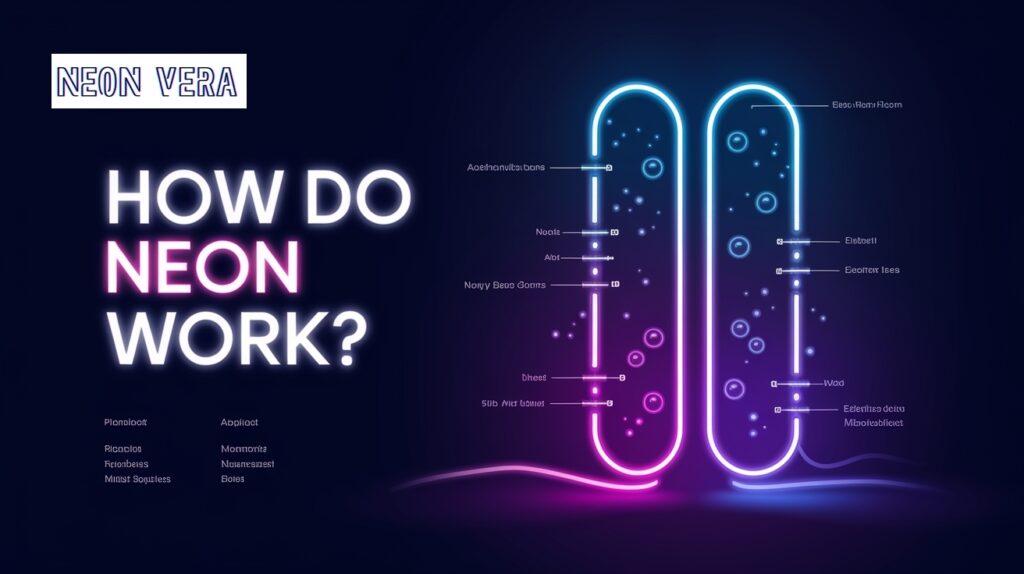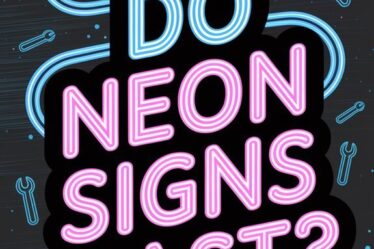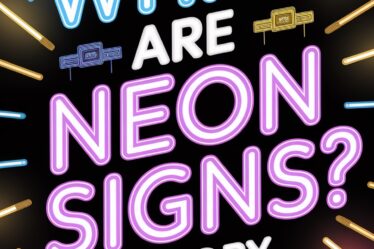
Neon signs operate by passing electrical currents through glass tubes containing noble gases. When electricity flows through the sign, electrodes excite the gas molecules, creating photons that produce signature colors – pure neon glows red-orange.
These carefully crafted glass tubes bend into custom shapes and designs, making storefronts and spaces visually striking. The complete process showcases both technical precision and artistic skill in creating these luminous displays.
The History of Neon Signs
You’ll find neon gas’s discovery in 1898 by William Ramsay and Morris Travers marked the beginning of an illuminating era.
Georges Claude revolutionized the commercial world when he revealed the first neon advertising sign in Paris in 1910, leading to widespread adoption of this eye-catching technology.
While neon sign popularity waned in the 1960s due to cheaper alternatives, you’ll now see a resurgence of these distinctive lights in art installations and retro-styled establishments.
Discovery of Neon Gas
The discovery of neon gas occurred in 1898 when British chemists Sir William Ramsay and Morris Travers isolated it from liquid air. By distilling and examining atmospheric gases at extremely low temperatures, they identified this rare noble element.
An electric current passed through their discovery produced a distinctive reddish-orange glow.
Neon comprises merely 0.0018% of Earth’s atmosphere, ranking as the fifth most abundant gas after nitrogen, oxygen, argon, and carbon dioxide.
Its rarity made early commercial applications both costly and challenging.
Georges Claude’s Innovation
French engineer Georges Claude made history in 1910 by creating the first neon lamp for practical use. By sending an electrical charge through sealed glass tubes filled with neon gas, he produced a bright orange-red glow.
Claude’s breakthrough came from developing a method to purify the neon gas and create secure electrodes that wouldn’t leak.
His innovation led directly to modern neon signs. The debut of his first neon advertising sign at the 1912 Paris Motor Show revolutionized commercial signage and urban lighting.
Decline and Revival
After dominating urban landscapes for decades, neon signs faced a sharp decline in the 1960s when cheaper plastic and LED alternatives hit the market.
Many businesses opted for these less expensive options, leading to the removal of countless iconic neon displays.
Neon artistry endures despite past setbacks. Since the 1980s, a creative renaissance has breathed new life into this luminous medium.
Artists and designers celebrate neon’s distinctive glow and craftsmanship through contemporary installations.
Today, neon signs illuminate museums, galleries, and trendy establishments while inspiring new generations of craftspeople.
The Science Behind Neon Signs
When you examine the science of neon signs, you’ll find that they work through ionized noble gases in a sealed glass tube that glows when electrified.
You can create different colors by using various noble gases like neon (red-orange), argon (lavender), or helium (pink), or by coating the inside of the tubes with fluorescent powders.
Neon signs are highly energy-efficient and can last up to 15 years with proper maintenance, making them a practical choice for long-term use.
How Neon Lights Work
Inside every neon sign, a fascinating process of physics and chemistry creates those vibrant, glowing colors you see.
When electricity flows through the electrodes, it energizes gas atoms within the glass tube. These excited atoms emit photons – tiny particles of light – as they return to their normal state.
The color depends on the noble gas used: neon produces red-orange, while argon creates blue light. Different phosphor coatings on the glass tubes generate a range of brilliant colors.

Color Variations
The science of neon sign colors relies on three key factors: gas choice, phosphor coatings, and glass color.
Pure neon gas creates the classic red-orange glow, while argon produces a pale blue light. Mercury gets combined with argon to boost brightness and efficiency.
Different phosphor coatings transform ultraviolet light into white, pink, yellow, and other vibrant hues. The glass tube’s color adds another dimension of customization.
Mixing gases, phosphors, and colored glass enables endless possibilities across the color spectrum.
Energy Efficiency and Lifespan
Beyond their vibrant colors, neon signs offer remarkable energy efficiency and longevity. A typical neon sign uses just 3-5 watts per foot, making it more energy-efficient than traditional fluorescent lighting.
These signs typically function for 8-15 years with proper maintenance, and many remain operational for decades.
Usage patterns and environmental conditions significantly impact a neon sign’s durability. Running them continuously shortens their lifespan, while 12-hour daily operation helps maximize longevity.
Their sealed glass tubes provide excellent protection from moisture and debris.
How Neon Signs Are Made
Creating a neon sign requires both skilled craftsmanship and artistic vision to bring glowing designs to life.
You’ll find that experienced neon craftsmen blend scientific knowledge with artistic talent as they bend glass tubes into precise shapes and determine ideal gas mixtures.
The process starts with a designer’s concept, which is then transformed through careful planning and meticulous execution into a luminous work of art.
Craftsmanship
Making neon signs requires skilled craftsmanship and meticulous attention to detail, as artisans must carefully bend glass tubes into precise shapes while working at temperatures exceeding 1,000°F.
Using specialized torches, craftsmen heat and shape glass tubes according to detailed blueprints, creating smooth bends while maintaining uniform diameter. Each component requires exact measurements to ensure proper gas flow and illumination.
The process also involves creating electrodes at both ends of the tube and testing for leaks before adding the neon or other noble gases.
Artistic Design
The artistic design of neon signs begins long before any glass-bending takes place. First, develop detailed sketches that show letter forms, graphic elements, and dimensions. Different gases create distinct colors, while phosphor coatings expand the available color options.
Design requirements must work within physical constraints. Sharp angles aren’t possible, and electrodes need proper placement in each letter. Signs should remain readable at intended viewing distances, with carefully positioned mounting points.
The design should maintain visual appeal during both daytime and nighttime hours.
Applications of Neon Signs
You’ll find neon signs lighting up storefronts, restaurants, and businesses worldwide as eye-catching advertising tools that draw customers in with their vibrant glow.
Beyond commercial applications, neon has become a medium for artists who create stunning sculptures and installations that transform public spaces into luminous works of art.
Architects also incorporate neon elements into building designs, using these radiant tubes to highlight structural features or create dramatic lighting effects that enhance modern facades.
Advertising and Commercial Use
Since their commercial debut in the early 1900s, neon signs have revolutionized outdoor advertising by transforming storefronts and cityscapes into vibrant, eye-catching displays.
Neon signs illuminate businesses globally, enhancing everything from corner shops to major retailers. They’re particularly effective for restaurants, bars, hotels, and theaters, creating an inviting atmosphere and increasing visibility.
Even in daylight, these signs stand out against their surroundings.
Custom neon designs transform logos, business names, and promotional messages into distinctive illuminated artwork. They’re energy-efficient, durable, and can operate continuously, making them a smart investment for your business’s advertising strategy.
Artistic and Architectural Uses
Beyond commercial advertising, neon signs have evolved into a versatile medium for artistic expression and architectural enhancement.
Neon art installations grace galleries, museums, and public spaces, showcasing sculptures and interactive displays. In architecture, neon lighting transforms building facades, highlighting structural elements and creating dramatic nighttime effects.
Architects integrate neon elements to enhance walkways, water features, and interior spaces. These distinctive lights appear in luxury hotels, modern homes, and cultural venues, combining practical illumination with visual impact.
The flexibility of neon allows for custom shapes and intricate designs that blend seamlessly with various architectural styles.
Advantages and Disadvantages
When you’re considering neon signs for your business, you’ll find they offer striking visibility and a nostalgic appeal that can attract customers even in poor weather conditions.
You’ll appreciate their long lifespan of up to 15 years and relatively low power consumption compared to traditional lighting options.
However, you’ll need to weigh these benefits against their higher initial costs, potential for breakage, and the specialized maintenance they require.
Benefits of Neon Signs
Neon signs have illuminated businesses for nearly a century, offering unique advantages that modern alternatives can’t match.
You’ll get exceptional visibility even in poor weather conditions, as neon’s bright glow cuts through rain, snow, and fog.
These displays consume less power than fluorescent lighting and can last up to 15 years with proper care.
Their versatile nature allows for unique shapes and designs that capture attention.
Neon signs benefit the environment since they contain no mercury and can be fully recycled.
Challenges
Despite their distinctive appeal, neon signs present several notable challenges to consider.
They consume significant electricity, which drives up operating costs. Glass tubing makes them vulnerable to breakage, while professional repairs prove costly and skilled technicians are scarce.
Over time, these signs may buzz or flicker, with colors fading at different rates. Weather exposure threatens transformers and connections.
Local signage regulations may restrict neon displays in certain areas. Proper disposal demands special handling because of noble gases and mercury content.
Modern Alternatives: LED Neon vs Traditional Neon
In recent years, LED neon has emerged as a popular alternative to traditional neon signs, offering businesses and consumers a different approach to achieving that classic neon glow.
LED neon signs combine flexible LED strips with PVC tubing to replicate the look of traditional glass neon. These modern versions deliver better energy efficiency and durability at a lower cost.
While traditional neon creates an authentic, handcrafted aesthetic that many still prefer, LED neon provides practical advantages like customizable colors, dimming capabilities, and notably lower maintenance requirements.
Conclusion
Now you understand the science behind neon signs – how noble gases and electrical charges create their mesmerizing glow. Whether choosing classic neon or LED alternatives, you’ll appreciate the skill behind these luminous displays.
Since its invention in 1910, neon technology has evolved while maintaining its distinctive appeal in cities worldwide. When you spot a neon sign, you’ll recognize the fascinating process producing its radiant light.



